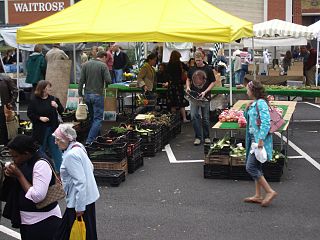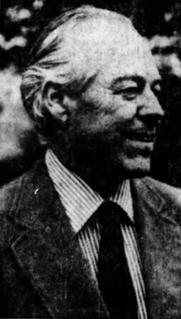John Robbins is an American author, who popularized the links among nutrition, environmentalism, and animal rights. He is the author of the 1987 Diet for a New America, an exposé on connections between diet, physical health, animal cruelty, and environmentalism.

Local food is food that is produced within a short distance of where it is consumed, often accompanied by a social structure and supply chain different from the large-scale supermarket system.

The product known as Kraft Dinner (KD) in Canada, Kraft Macaroni & Cheese in the United States and Australia, and Cheesey Pasta in the United Kingdom is a nonperishable, packaged dry macaroni product by Kraft Foods Group, traditionally cardboard-boxed with dried macaroni pasta and a packet of processed cheese powder. It was first introduced under the Kraft Dinner name simultaneously in both Canada and the U.S. in 1937. The brand is popular with Canadians, who consume 55% more boxes per capita than Americans.

Barbara Kingsolver is an American novelist, essayist and poet. She was raised in rural Kentucky and lived briefly in the Congo in her early childhood. Kingsolver earned degrees in biology at DePauw University and the University of Arizona and worked as a freelance writer before she began writing novels. Her widely known works include The Poisonwood Bible, the tale of a missionary family in the Congo, and Animal, Vegetable, Miracle, a non-fiction account of her family's attempts to eat locally.

Michael Kevin Pollan is an American author and journalist, who is currently the Knight Professor of Science and Environmental Journalism at the UC Berkeley Graduate School of Journalism.

This is an overview of media in Vancouver, British Columbia.

The Tyee is an independent online Canadian news magazine that primarily covers British Columbia. It was founded in November 2003 by its editor-in-chief, David Beers, an award-winning writer and former features editor at The Vancouver Sun. Since its launch it has recruited a number of other writers, including Andrew Nikiforuk, Andrew MacLeod, Katie Hyslop, Crawford Kilian, Michael Harris, Colleen Kimmett, Geoff Dembicki, Charles Campbell, Christopher Cheung, Tom Barrett, Sarah Berman, Chris Wood, Ian Gill, Chris Pollon, Steve Burgess, Murray Dobbin, Michael Geist, Terry Glavin, Mark Leiren-Young, Rafe Mair, Will McMartin, Shannon Rupp, Vanessa Richmond and Dorothy Woodend.
Norene Lynn Gilletz was a Canadian Jewish cookbook writer, food consultant, and food writer.

Animal, Vegetable, Miracle: A Year of Food Life (2007) is a non-fiction book by Barbara Kingsolver detailing her family's attempt to eat only locally grown food for an entire year.
Jessica Prentice is a chef, author, and founding member of Three Stone Hearth, a community-supported kitchen in Berkeley, California. She is known for coining the word locavore, which is a movement in which people seek to eat locally grown foods, often defined as those available within a 100-mile radius.
A low-carbon diet refers to making lifestyle choices related to food consumption to reduce resulting greenhouse gas emissions (GHGe). Choosing a low carbon diet is one facet of developing sustainable diets which increase the long-term sustainability of humanity.
Sociology of food is the study of food as it relates to the history, progression, and future development of society. This includes production, distribution, conflict, medical application, ritual, spiritual, and cultural applications, environmental and labor issues.
James Bernard MacKinnon, commonly cited as J.B. MacKinnon, is a Canadian journalist, contributing editor and book author. MacKinnon is best known for co-authoring with Alisa Smith the bestselling book The 100-Mile Diet: A Year of Local Eating, encouraging readers to focus on local eating as a way to address current environmental and economic issues. MacKinnon and Smith also collaborated in the creation of the Food Network Canada television series The 100 Mile Challenge, based on the book. He has won six National Magazine Awards, and the 2006 Charles Taylor Prize for best work of Literary Non-Fiction.
James E. McWilliams is Professor of history at Texas State University. He specializes in American history, of the colonial and early national period, and in the environmental history of the United States. He also writes for The Texas Observer and the History News Service, and has published a number of op-eds on food in the New York Times, the Christian Science Monitor, and USA Today. Some of his most popular articles advocate veganism.

The 100 Mile Challenge is a Canadian reality television series produced by Paperny Entertainment and aired on Food Network Canada. The series follows the lives and eating habits of six families living in Mission, British Columbia, who, for a period of 100 days, agreed to only consume food and drink that has been grown, raised and produced within a 100-mile radius from Mission. The series is based on the concept of local food consumption as described in the book The 100-Mile Diet authored by J.B. MacKinnon and Alisa Smith where the two authors describe their experience of eating locally for one full year. To coincide with the premiere of the series, FoodTV.ca launched a companion website that Canwest described as "the largest, most innovative and interactive companion website to a series to date".

Michael Herschel Greger is an American physician, author, and professional speaker on public health issues, best known for his advocacy of a whole-food, plant-based diet, and his opposition to animal-derived food products.

Meeru Dhalwala is an author, chef and co-owner, with her ex-husband Vikram Vij, of the Indian restaurants Vij's and Rangoli in Vancouver, British Columbia.

Ten Talents is a vegetarian and vegan cookbook originally published in 1968 by Rosalie Hurd and Frank J. Hurd. At the time, it was one of the few resources for vegetarian and vegan cooks. The cookbook promotes Christian vegetarianism and a Bible-based diet, in keeping with teachings of the Seventh-day Adventist Church. By 1991, the 750-recipe cookbook was entering its 44th printing and had sold more than 250,000 copies. An expanded edition with more than 1,000 recipes was issued in 2012.

Guy Richard Godfrey Mackarness was a British psychiatrist and low-carbohydrate diet writer. He is best known for his book Eat Fat and Grow Slim, published in 1958. Mackarness was an early advocate of the Paleolithic diet and authored books on food allergies.












